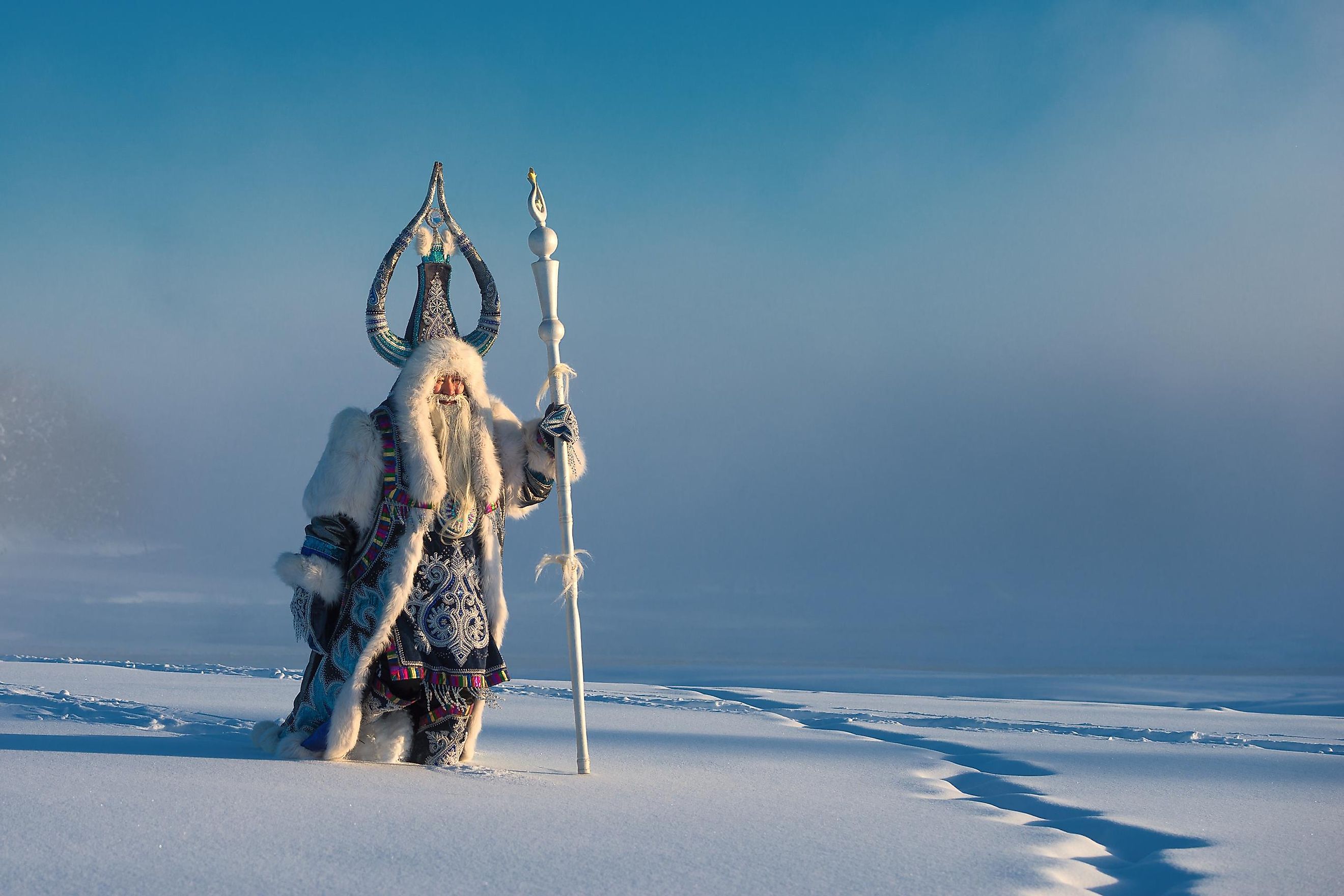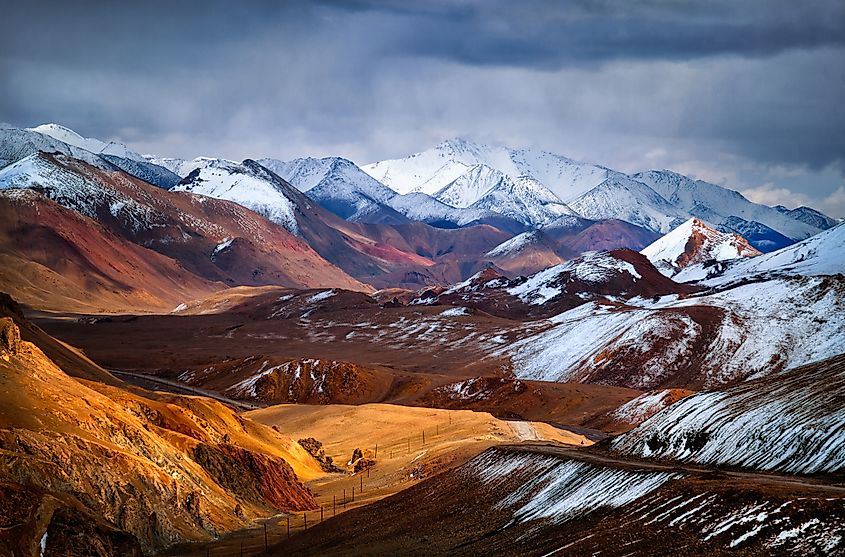
The 10 Coldest Countries In The World
The world's coldest countries are spread around the planet but share common geographical characteristics. They are landlocked or island nations, Nordic countries, and those near a pole and/or the Arctic Circle. The island states and countries with an ocean shore often see warmer temperatures along the coast, while inland countries orientate themselves south-north from warmest to coldest. These are the coldest countries in the world by annual mean temperatures.
1. Canada - 22.37°F

Oh, Canada; many know you are cold, but making it to the top of this list is impressive for the second-biggest country in the world. Canada is sparsely populated, with only four people per square km. The vast country has a wide variety of climates, with the northern two-thirds experiencing extremely frigid conditions all year round. Winters are snowy and cold across the country. January is the coldest month historically, but February has shown more teeth in recent years.
Temperatures vary dramatically across the various regions, with harsh winters in the interior that can hold 5°F or less for weeks at a time and drop to -40°F, usually a few days after a very heavy snowfall. Winters in the northern and eastern parts of the state are even harsher and last for five months. The coldest temperature ever recorded was -63.0 °C (-81.4 °F) in Snag, Yukon Territory, in 1947. With all of the wind-chilly temperatures, some hotels even feature heated doors.
2. Russia - 22.82°F

The large landlocked transcontinental country extends from Eastern Europe to the easternmost edge of mainland Asia. With a massive section of the land being far from the sea, the continental climate dominates in the country. Much of Russia is characterized by mild summers and very long, cold, snowy, and frosty winters. The temperatures remain around 37°F in summers, 18°F on a normal day in January, and often reach -40°F during severe winters. Most of northern-European Russia and Siberia, between the Scandinavian Peninsula and the Pacific Ocean, has a subarctic climate.
The extremes in the interior of northeastern Siberia dipped to a historic low of -89.86 °F on February 6, 1933, in Oymyakon. Russia's inhabited village of some 500-900 permanent residents is one of the world's top-coldest permanently-inhabited settlements. There, gadgets freeze up, batteries die, and residents eat mostly meat with no grown crops and near-impossible transportation. The country with two months of summer and no sunlight for the rest of the year over large areas, at least, can enjoy the "White Nights" in St. Petersburg.
3. Mongolia - 30.74°F

The small landlocked nation between Central and East Asia made "headlines" in history as home to the ever-warring Genghis Khan. There are various geopolitical cultures today, living in the third coldest country in the world. This may explain the rumbustious people's nature in the past as a way to stay warm in the sub-freezing state through much of the year. The "Land of the Eternal Blue Sky" boasts the lowest temperature ever recorded at -67.5 °F in Züüngovi, Uvs Province, on a December day in 1976.
Mongolia features a dry continental climate with short summers and freezing temperatures in winter. The long, snowy, and windy winter can have temperatures dipping to as low as -40.0°F. During November and March, temperatures may rise above freezing, with the warmest April and October having temperatures peak at around 100.4°F in the southern Gobi region. Mongolia is one of the last nations where some people still live nomadically but has adapted for the majority to withstand harsh temperatures with on-par, modern ways.
4. Norway - 34.70°F

Most of this Nordic country lies above the Arctic Circle, within the subarctic climate zone. Norway could have been colder, but for the moderating effects of the North Atlantic and Norwegian ocean currents raising the air temperature of the coastal areas. Inland Norway, however, faces greater extremes with a striking difference between summer and winter temperatures. Norway's beautiful mountains are under an even-more shiver-worthy Polar Tundra climate with lower degrees. Finnmarksvidda, Norway's largest plateau, experiences the coldest weather in mainland Finland. The cold country throughout the year is home to warm people who know how to welcome you in their home, even in the village of Karasjok, which broke the country's coldest-ever record in the late 1900s, registering a frigid -60°F.
5. Kyrgystan - 34.79°F

Officially, the Kyrgyz Republic, Kyrgyzstan, is a small landlocked country in Central Asia with a surprisingly varied climate. The southwestern Fergana Valley often reaches sweltering 104°F in summer, while the mountains stay persistently cold at around -22°F from December to February. The Middle Eastern periphery nation features an average temperature of 34.79°F, while the recording-breaking low was -64.5°F. The harsh and cold winters cover several valleys' landscapes and mountain slopes with snow.
6. Finland - 35.06°F

The Northern European country must stay cold with chilly neighbors like Sweden, Norway, and Russia. Finland ranks sixth with a mean temperature of 35.06°F and a record-low of -60.7°F. The country is known for the world's most prolonged winter sessions of around 100 days in the southwest and 200 days in northern Lapland.
The four-month winters are characterized by an average of -4°F, extreme snowfall, blizzards, and cold gusty winds that induce a hibernation mode in residents until it is over. Nature gives back to the resilient Scandinavians with northern lights that commonly color the skies from the end of August to early April in the northern part of the country.
7. Iceland - 35.15°F

Another Nordic country and European island nation, Iceland, is most known as land once settled by the Vikings. Today, it proudly joins the ranks of the world's coldest countries with a mean annual temperature of 35.15°F. The Polar Tundra climate keeps Iceland perpetually cold, with chilly summers around 50°F and winters with an average of 37°F in January. The unique latitude, oceanic influence, and warm currents of the North Atlantic Gyre keep temperatures mild with minor differences between the extremes, not letting Iceland freeze despite its name.
The lowlands in the south average 32°F in winter, while the northern portion registers around 14°F, and the lowest temperature on record is -39.5°F. This region is subject to sudden wind gusts, precipitation, and dramatic temperature drops resulting in rapid visibility loss. One does not visit the country for sunbathing in summer, nor for sun-lit streets of cities and towns, but for the beautiful Blue Lagoon, volcanoes, and glaciers, along with the must-see Aurora Borealis.
8. Tajikistan - 35.60°F

Another Central Asian landlocked country on this list, Tajikistan, is highly mountainous, with 93% of its land area being covered by the lofty peaks of Pamir, Alay Mountains, and the Tian Shan ranges. Thus, it is no wonder that this country finds a mention on this list. The country experiences a continental, semiarid, and subtropical climate which dramatically changes with elevation. Temperatures in the country's lower elevations range from 30.2 to 37.4 °F in January, while in the higher sections, like the mountains of the eastern Pamirs, it can be as low as 5 to −4 °F in the same month.
9. Sweden - 35.78°F

Again with the long, harsh, and paralyzing winters, the Nordic country in Northern Europe crushes the ninth spot on this list. It is part of the Arctic Circle with a mean annual temperature of 35.78°F, and a record-low of -63.4°F in Malgovik, Västerbotten County. The northern reaches see relatively mild summers and frigid winters with common -40°F readings and landscapes under full snow cover for months. Mid-Sweden and the southern part are spared with much "lower" temperatures year-round, with subfreezing winter days of around -22°F.
10. Estonia - 41.18°F

Estonia, a Baltic state in northern Europe, lies in the transition zone between continental and maritime climates. It rounds off this list at the tenth place with a mean annual temperature of 41.18°F. The coastal areas and islands have a milder climate due to the influence of the Baltic Sea while places inland experience severe winters. February is the coldest month in Estonia.
It is interesting how nature loves to play with extremes, including the magnificent Aurora Borealis, visible from several countries. It also contains some of the world's coldest and hottest places in one nation and produces ironic and unlikely conditions in others. Although Mongolia ranks colder, its steamy summer months are envied by Norway, which experiences sweater-worthy conditions even in summer. All of it, even the Northern Lights, can be explained with science and geography, but let us keep it under the veil of Mother Nature's human character and magical touch.
| Rank | Country | Average Yearly Temperature (°C) | Average Yearly Temperature (°F) |
|---|---|---|---|
| 1 | Canada | -5.35 | 22.37 |
| 2 | Russia | -5.1 | 22.82 |
| 3 | Mongolia | -0.7 | 30.74 |
| 4 | Norway | 1.5 | 34.70 |
| 5 | Kyrgyzstan | 1.55 | 34.79 |
| 6 | Finland | 1.7 | 35.06 |
| 7 | Iceland | 1.75 | 35.15 |
| 8 | Tajikistan | 2 | 35.60 |
| 9 | Sweden | 2.1 | 35.78 |
| 10 | Estonia | 5.1 | 41.18 |
| 11 | Switzerland | 5.5 | 41.90 |
| 12 | Latvia | 5.6 | 42.08 |
| 13 | Liechtenstein | 5.65 | 42.17 |
| 14 | North Korea | 5.7 | 42.26 |
| 15 | Georgia | 5.8 | 42.44 |
| 16 | Belarus | 6.15 | 43.07 |
| 17 | Lithuania | 6.2 | 43.16 |
| 18 | Austria | 6.35 | 43.43 |
| 19 | Kazakhstan | 6.4 | 43.52 |
| 20 | Slovakia | 6.8 | 44.24 |
| 21 | China | 6.95 | 44.51 |
| 22 | Armenia | 7.15 | 44.87 |
| 23 | Bhutan | 7.4 | 45.32 |
| 24 | Denmark | 7.5 | 45.50 |
| 25 | Czech Republic | 7.55 | 45.59 |
| 26 | Andorra | 7.6 | 45.68 |
| 27 | Poland | 7.85 | 46.13 |
| 28 | Nepal | 8.1 | 46.58 |
| 29 | Ukraine | 8.3 | 46.94 |
| 30 | United Kingdom | 8.45 | 47.21 |











